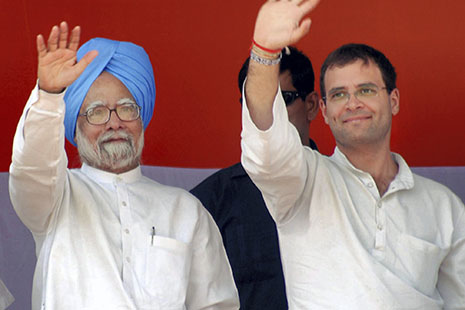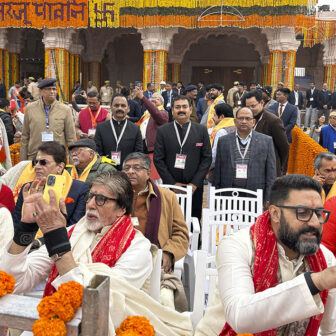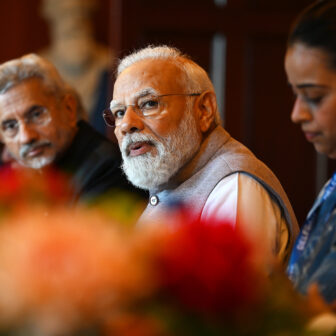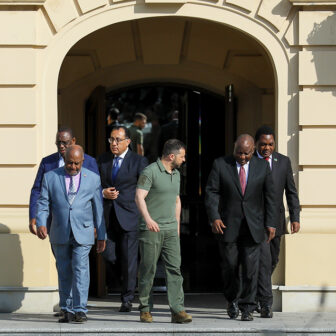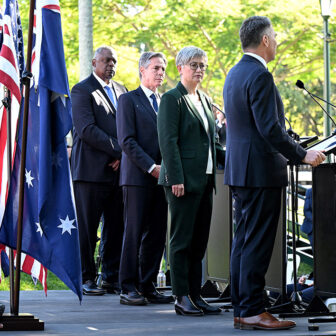AS AN EXPLANATION for the results of India’s fifteenth general elections, one particular picture is worth a thousand words – or ten or twenty million votes. It shows an old man with spectacles, a white beard and a pale blue turban. His raised right hand acknowledges cheers, and his beard masks what may be just a hint of a smile. Next to him, slightly sturdier, is a good-looking, clean-shaven, clear-eyed young man. His hand also acknowledges cheers, and there is no question: he is smiling. He has a right to.
The duo is Manmohan Singh, seventy-five, prime minister of India, and Rahul Gandhi, thirty-eight, grandson of Indira Gandhi, great-grandson of Jawaharlal Nehru and red-hot hope of his Congress Party. The picture appeared in the Indian press on 17 May, the day after election results showed that the Congress had surpassed every prediction. In India’s first-past-the-post elections, it won 206 seats in the 545-member lower house – sixty more than it had held in the previous parliament.
Having governed for the previous five years through an unwieldy coalition, the Congress last week found it relatively easy to line up the necessary allies to form a new government. Rahul Gandhi is not to enter the cabinet – yet. He remains general secretary of the party and oversees the Youth Congress. His mother, Italian-born, Sonia Gandhi, is party president. They and the prime minister can take credit for the surprisingly successful election strategy. Against much advice, they eschewed alliances and contested every seat in India’s biggest state, Uttar Pradesh, where they were not expected to go well. They were told Congress would get badly beaten; instead, it re-established itself in the heart of India.
As analysts ponder reasons for the Congress success, the picture of the clever, honest older man and the pedigreed, untried (but also untainted) younger one looms large. It is particularly potent when placed against the images of the Congress Party’s various rivals. L.K. Advani, the eighty-one year old leader of the opposition Bharatiya Janata Party, the BJP, led an uninspired campaign that was unable to make poverty or national security vote-grabbing issues. The BJP’s other leaders lacked glamour, fire and ideas. The party’s attempt to rev up Hindu-nationalist enthusiasm by defending an anti-Muslim speech made by Rahul Gandhi’s clod-hopping cousin, Varun, flopped. Indeed, the episode may have drawn Muslim voters back to a Congress Party from which they had drifted. (Varun, however, did win a seat.)
If you had gone to the polling booth uncertain of whom to vote for but with images of Advani and of the Manmohan–Rahul combination in your head, your finger on the button of the electronic voting machine might well have twitched in the direction of the wise elder and the young brave. (You would not, however, have had the chance to vote for Manmohan Singh. Not much of a stump politician, he sits in the indirectly elected upper house of the parliament.)
Of course there was much more to it than that. Attempts to divine the “mind of the Indian voter” are notably unrewarding. That’s not surprising, given that there are more than 700 million eligible voters and more than 400 million of them voted – and that India has twenty-two official languages and 350 million mobile phones, major newspaper industries operating in ten different scripts, and more than fifty television news channels feeding into 110 million households and working in all the big languages. If there were a “mind of the Indian voter,” it would be a delirious place.
What this election does suggest, however, is that the communications revolution transforming India creates possibilities for “nation-wide” movements and verdicts.
This contradicts the assumption that as more and more local groups organised to take part in politics, India’s electoral system would fragment – that the destiny of the world’s largest democracy would lie in a succession of shaky coalition governments based on constantly changing alliances of regionally based parties.
To be sure, the Congress Party is a long way from the days when it commanded comfortable majorities in its own right. But in 2009 it has won seats in every major state, and to most observers’ surprise it is back in business in north India, where it won seventy out of 191 seats across six states.
Overall, the Congress won just over 27 per cent of the votes cast, which delivered 38 per cent of the seats in the Lok Sabha (house of the people – the lower house of the parliament). The BJP, which led a coalition government from 1999–2004, won 18 per cent of the vote and 116 seats (21 per cent of the seats). The next largest vote-share went to the Communist Party of India (Marxist) with just over 7 per cent – not enough to stop it being rolled back to sixteen seats from the influence-wielding forty-five it held in the previous parliament.
This may be the end for India’s two old Communist parties, the CPI (Marxist) and the even weaker CPI, which is down to two seats from ten. The CPI (Marxist)’s leaders are urbane and highly educated, but they are locked in a worldview formed during the Cold War. Their party machines in West Bengal and Kerala too often look like standover rackets that alienate more citizens than they benefit. And the parties’ concerns often seem remote from those of the toiling masses they seek to represent.
IT IS NOT as if toiling masses were in short supply. A 2007 government report estimated that more than 75 per cent of the Indian population spent less than 20 rupees a day on food (50c Australian). The report termed such people “poor and vulnerable.”
In Indian elections, poor people vote in larger proportions than the upper classes. So where did their votes go? They did not significantly favour the Communists. Nor did they go as strongly as expected to the party of Mayawati, fifty-three, the fierce Chief Minister of Uttar Pradesh, India’s largest state with a population of 190 million. Mayawati is a Dalit (the favoured term today for “untouchable”) who built the Bahujan Samaj Party, which governs her state. Her party won only twenty seats, not the thirty or so predicted, though it took nearly 6 per cent of the vote nationally.
About 15 per cent of Indians – close to 180 million people – are Dalits, most of them heart-rendingly poor. Another 7 per cent of the population (80 million people) are “tribals”, marginalised people living in hill country which is increasingly valued for the minerals that lie under it. These poor and stigmatised Indians are confronted with three political possibilities. The first is electoral politics – the Mayawati option. But Mayawati, though flamboyantly symbolic, is yet to deliver material improvements.
The second possibility is revolt. A “Maoist” movement operates in about 180 of the remotest of India’s 600 districts. Maoists tried to disrupt the first phase of the elections, though without much success. But with South Asia awash in weapons that overflow from Afghanistan and Sri Lanka, Maoist movements will continue to confront governments that try to displace traditional occupants of land to dig mines and dam rivers.
The third option for the poor is religious and social revival. Some of the tumultuous consequences of such movements were seen in the past week halfway around the world in Vienna, where a preacher associated with a Dalit-improvement movement among Sikhs was murdered. The apparent reason was that the low-status preacher was held by higher-status people to be committing sacrilege. When news of the murder reached India, rioting followed across Punjab state, and the army had to be called out.
In this election, poor voters seem to have chosen a variation on the first option, returning to Congress in significant numbers. Post-election interviews indicate that two programs launched by the previous government have had an impact among the poor in rural India, where 75 per cent of the population still lives (though less than 20 per cent of GDP now comes from agriculture). The National Rural Employment Guarantee Program aims to provide, as a right, 100 days’ work at a basic wage for anyone in the countryside who asks for it. A related program has absolved small farmers from repayment of bank loans. For all their flaws, these programs touch millions of people and have bolstered support for the Congress Party.
SO DOES the new government lie on a bed of nails or roses? It’s not totally made up of nails. India has been relatively cushioned from the global recession. The stock market liked the election results, and growth is estimated to be about 4 per cent for the current year and 6 per cent in 2009–10. The new ministry will be largely free of the shackles that hobbled its predecessor, which depended on a dozen minor parties plus the left. The new government will have the opportunity to renovate the education system, continue economic reform and improve infrastructure.
There are two views about whether this will happen. Some argue that, having seen the electoral benefits of expenditure on the poor, the government will concentrate on such activity and that the pace of other change will be slow. Others argue that the old prime minister is now a man with a mandate and an urgent mission. He is not expected to serve the full five-year term, and the betting is that efforts will be made to install Rahul Gandhi as leader at some midway point. According to this line, Manmohan Singh will press hard for accelerated economic change – increased foreign investment and sell-offs of public-sector enterprises, for example – and that external pressures will help him to achieve this. He is, after all, an economist whose first book was called India’s Export Trends and the Prospects for Self-Sustained Growth, published in 1964 when India’s economic nostrum was “import substitution,” not “export-led growth.”
There will be pressure to strengthen India’s global diplomacy. Its foreign affairs bureaucracy has brilliant people at the top, but it does not have enough of them, and it lacks the capacity to talk to the world in sustained, sophisticated ways. China outnumbers, outspends and outshines it, as senior Indian diplomats have pointed out.
One hint that this may change is the presence in the outer ministry of newly elected Shashi Tharoor, aged fifty-three, novelist, diplomat and a former under-secretary general at the United Nations. On the other hand, the new external affairs minister will be an old Congress politician, S. M. Krishna, seventy-seven, US-trained in the 1960s, and a former chief minister and governor.
Other key cabinet posts have also gone to Congress veterans: Pranab Mukherjee, seventy-three, from West Bengal, a long-time devotee of Indira Gandhi and her family, moves from External Affairs to Finance; P. Chidambaram, sixty-three, from Tamil Nadu retains Home and A. K. Antony, sixty-eight, from Kerala, stays at Defence. Kapil Sibal, sixty, well known to Australian diplomats and policy-makers for his work as science minister in the previous government, is likely to get Human Resources, crucial for the reform of education.
One of the heroes of this election was again the EVM – the electronic voting machine, used extensively since 1999. About 1.1 million of these robust, self-contained little boxes were deployed in 800,000 polling booths. Though the elections took five weeks and five phases of polling to complete, the results were known within a few hours once the computerised count began on 16 May. Coupled with a photo identification card and photo electoral roll, which now includes 85 per cent of voters, the system makes malpractice difficult and labour-intensive. A mark of the system’s success was the result in West Bengal, where the CPI (Marxist), reputed to have the country’s best-organised electoral muscle, suffered its first big setback in decades and voter turnout exceeded 80 per cent.
In India, however, diversity prevails in all things, and a squeal of complaint against the EVMs has come from the southern state of Tamil Nadu. The party of former chief minister and film star, the mystique-laden Jayalalitha, claims the EVMs were rigged. Her AIADMK party won a disappointing eight seats.
India’s electoral system is now so embedded in daily life that it can cope with such complaints. Back in 1971, defeated candidates took a case to the Supreme Court claiming that they had lost because the government of the day had doctored the ballot papers with invisible ink. That was ten general elections ago. •
